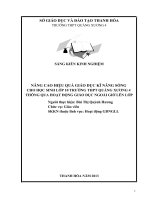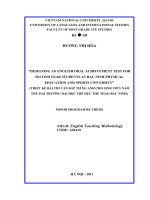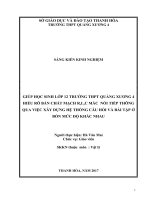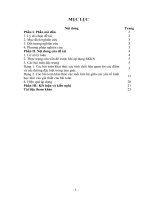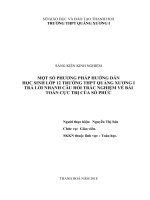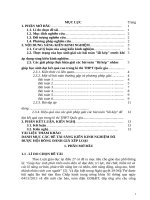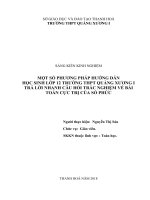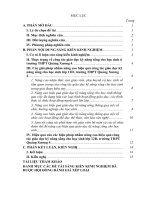Áp dụng đường hướng viết như một quá trình để nâng cao kĩ năng viết cho học sinh lớp 12 Trường THPT Quảng Xương 1
Bạn đang xem bản rút gọn của tài liệu. Xem và tải ngay bản đầy đủ của tài liệu tại đây (1.65 MB, 56 trang )
VIETNAM NATIONAL UNIVERSITY, HANOI
UNIVERSITY OF LANGUAGES AND INTERNATIONAL STUDIES
FACULTY OF POST-GRADUATE STUDIES
DƯƠNG THỊ HÒA
“DESIGNING AN ENGLISH ORAL ACHIEVEMENT TEST FOR
SECOND YEAR STUDENTS AT BAC NINH PHYSICAL
EDUCATION AND SPORTS UNIVERSITY”
(THIẾT KẾ BÀI THI VẤN ĐÁP TIẾNG ANH CHO SINH VIÊN NĂM
THỨ HAI TRƯỜNG ĐẠI HỌC THỂ DỤC THỂ THAO BẮC NINH)
MINOR PROGRAMME THESIS
FIELD: English Teaching Methodology
CODE: 601410
HÀ NỘI - 2011
VIETNAM NATIONAL UNIVERSITY, HANOI
UNIVERSITY OF LANGUAGES AND INTERNATIONAL STUDIES
FACULTY OF POST-GRADUATE STUDIES
DƯƠNG THỊ HÒA
“DESIGNING AN ENGLISH ORAL ACHIEVEMENT TEST FOR
SECOND YEAR STUDENTS AT BAC NINH PHYSICAL
EDUCATION AND SPORTS UNIVERSITY”
(THIẾT KẾ BÀI THI VẤN ĐÁP TIẾNG ANH CHO SINH VIÊN NĂM
THỨ HAI TRƯỜNG ĐẠI HỌC THỂ DỤC THỂ THAO BẮC NINH)
MINOR PROGRAMME THESIS
FIELD: English Teaching Methodology
CODE: 601410
SUPERVISOR: Đỗ Bá Quý, MEd.
HÀ NỘI - 2011
v
TABLE OF CONTENTS
STATEMENT OF AUTHORSHIP………………………………………………… I
ACKNOWLEDGEMENTS ii
ABSTRACT iii
LIST OF TABLES………………………………………………………………… . . iv
TABLE OF CONTENTS…………………………………… ……… … v
PART A. INTRODUCTION
1. Rationale of the study………………………………………………………… …… 1
2. Aims of the study…………………………… …………………………… …… 2
3. Research questions……………………………… ……………………………… …. 3
4. Scope of the study ………………………………………………………………… … 3
5. Methodology…………………………………………………………………… 3
6. Design of the study…………………………………………………………………… 3
PART B. DEVELOPMENT
Chapter 1. Literature review
1.1. Language testing………………………………………………………………… … 4
1.2. The role of testing……………………………………………………………… …. .5
1.2.1. Testing and teaching……… ……………………………………………… … 5
1.2.2. Purpose of language testing…………………………………………………. . . .6
1.3. Achievement test…………………………………………………………………… 7
1.3.1. Definition………………………………………………………………… 7
1.3.2. Kinds of achievement tests………………………………………………… 8
1.4. Criteria of a good test………………………………………………………………. . 9
1.4.1. Validity………………………………………………… …………… … 10
1.4.2. Reliability……………………………………………………………… … 11
1.4.3. Practicality……………………………………………………………… … 12
1.4.4. Discrimination……………………………………………………………. .12
1.5. Testing speaking skills……………………………………………………………… .12
1.5.1. What is a spoken test …………………………………………………… 12
1.5.2. What should be tested…………………………………………………… 13
1.5.2.1. Listening comprehension…………………………………………… … 13
1.5.2.2. Grammatical appropriacy…………………………………………… …14
1.5.2.3. Ease of speech and fluency……………………………………… … … .14
1.5.2.4. Content…………………………………………………………… …… .15
1.5.2.5. Conversational skill………………………………………………….…. .15
vi
CHAPTER 2. Methodology
2.1. The current situation of English teaching and learning at BAC NINH UPES …… .16
2.2. Participants…………………………………………………………………………. .16
2.2.1. The teachers…………………………………………… ……………… 16
2.2.2. The students…… …………………………………………………… 16
2.3.Overview the material used for second year students at BAC NINH UPES 17
2.4. Current testing situation at BAC NINH UPES……………………… ……… 19
2.5. Results and discussions
2.5.1 The subjects……………………………………………………………… 20
2.5.2 Instruments for collecting data………………………………………………21
2.5.3 Analysis of the collected data…………… ……………………… … … …21
2.5.3.1 Teachers’ survey questionnaire and interview … …… … 21
2.5.3.2 Students’survey questionnaire ……… …… … … … 22
2.5.4. Results……………………………………………… …… … .23
CHAPTER3. Towards designing an oral achievement
test for second year students at BAC NINH UPES
3.1. Suggestions for improvement of the existing English oral achievement test… … 24
3.1.1. Small talk…………………………………………………………… … 25
3.1.2. Picture………………………………………………………………… . 26
3.1.3. Oral interview…………………………………………………………… . 27
3.2. Proposed construction for an oral test for second year students at BAC NINH UPES
3.2.1. Objectives……………………………………………………………… … 28
3.2.2. Table of specifications …………………………… ………………… … 28
3.3.2.1. Test skills……………………………………………………… …… 29
3.3.2.2 Test content……………………………………… ………………… 29
3.3.2.3 Test format………………………………………… ……………… … 29
3.3.2.4. Rubrics………………………………………………………………… 29
3.3.2.5. Marking……………………………………………… …… ……… 29
3.3.2.6. Detailed construction for the test……………………………… …… 29
3.3. Test administration and marking scheme……………………… …………… 29
3.3.1. Test administration……………………………………… …………… 30
3.3.2. Marking scheme………………………………………… …………… 30
3.3.2.1. Marking………………………………………………… …………… 30
3.3.2.2. Detailed marking scales……………………………………………… … 30
3.3.2.3. Testing procedures…………………………………………………… 32
3.3.2.4. The marking training program ……………………………………… . 33
3.3.3. Conclusion……………………………………………………………… 35
vii
PART C. CONCLUSION
1. Conclusions………………………………………………………………… … …36
2. Limitations and suggestions for further study…………………… ……… … 37
REFERENCES……………………………………………… …………………… .38
APPENDIX A QUESTIONNAIRES…… … …………………… ……………….I
APPENDIX B THE CURRENT TEST …… ……………………… ………… .IX
APPENDIX C THE SAMPLE TEST…… …………………… …………… X
APPENDIX D THE ANSWER KEY FOR SAMPLE TEST……… ………. XI
APPENDIX E THE EXTRA SPEAKING MATERIALS……… ………… .XII
1
Part A. Introduction
1. Rationale for the study
Language is not only a main medium of education, but also intrinsically involved in
every school subject to such a degree that education should be viewed as a “ languaging”
process.
The twentieth century has seen the rise of English as the most widely used
international means of communication with different purposes. Anyone no matter where he
lives is likely to be aware of the fact that having knowledge of English helps him achieve
the latest information on sience and technology and intergrade himself into the outside
world. In Vietnam, English has received widespread attention.
Bac Ninh Physical education and Sports University plays a very important role in
training well qualified and experienced teachers of sports and coaches to satisfy the needs
of the country. The communicative approach to Language Teaching with the most effective
and modern teaching techniques have been applied to develop students’ linguistic and
communicative competence by the teachers from this university. The teachers make full use
of time to develop the four language skills during the course in an attemp to help their
students communicate effectively have a successful communication in the target language.
However, teachers should not be confined to imparting teaching and learning with testing.
It is of special importance in educational system, which is highly competitive as testing not
only acts as an indirect stimulus to learning but plays a crucial role in determining the
success or failure of one’s own career. In the World Yearbook of education 1969,
Lauwerys and Seaton highlights: “Thus, testing is an important tool in educational light
both the nature of language proficiency and language learning”.
In addition, testing also pushes up teaching and learning activities. As Nga (1977) notes:
Tests are assumed to be powerful determiners of what happens in classrooms and it is
commonly claimed that they affect teaching and learning activities both directly and
indirectly.
No one can deny the fact that testing is an important part in teaching and learning
process, but has it been paid enough attention yet? Having taught English for students at
Bac Ninh University of Physical education and sports for nearly 16 years, author of this
study has designed tests of all four language skills, especially the speaking skills. She has
2
also administered and marked these tests. Her teaching experience shows that there still
remain some problems that need to be solved such as the test content, the gap between what
is tested and what is taught, the reuse of tests from years to years, from class to class. As a
result, tests may lack of validity and realibility.
Since 2010 at Bac Ninh UPES students have been required to do an oral
achievement test at the end of each semester. Having good English result in the first year
enables them to have better result in their specialty. Knowing the importance of speaking
skill for students at UPES, teachers in the English group regard oral achievement test as a
means to reinforce students’ knowledge and motivate their learning.
On the ground of the problem already mentioned, the author has decided to
choose Designing an English Oral Achievement Test for Second Year students at Bac
Ninh Physical Education and Sports University (Bac Ninh UPES) in an attemp to solve
the testing problems here and share her testing experience with her colleages and those who
are concerned with this area.
2. Aims of the study
The study aims at examining the current testing situation and English tests at Bac
Ninh UPES towards designing an English oral achievement test for second year students.
With the above- mentioned rationale, the specific aims of the study are:
+ Evaluating the current situation of English oral test in terms of its content, time
allowance and marking scales.
+ Investigating teachers’suggestions for improvement of the current testing
situation in general and oral test in particular.
+ Proposing a sample test as an illustration of a newly designed test based on the
old one.
3. Research questions
To gain the above aims of the study, the following questions are addressed:
(1) What is the current English oral testing situation at Bac Ninh UPES?
(2) What are the teachers’suggestions for improving the current English testing
situation for the second year students at Bac Ninh UPES?
(3) What test components and test contents are considered to be appropriate for the
intended English oral achievement test?
4. Scope of the study
3
Because of limitation of the time, the author of the study does not cover testing
issues for all the four skills, but only places emphasis on the third semester English oral
achievement test for second year at Bac Ninh UPES.
It deals with the general ideas of language testing, of the current test and the design of the
final oral achievement test for the second year students at Bac Ninh UPES.
5. Methodology
The above-given questions are to be answered by means of:
(1) Gathering reference materials; analyzing and synthetisizing the findings into principles,
qualities and formats as the basis to evaluate the current testing situation at Bac Ninh UPES
toward designing an English oral achievement test for second year students.
(2) Imploying questionnaires, interviews, opinion exchanges and experimental tests to
collect data for the study
6. Design of the study
The study consists of three parts and each one presents a set of related issues:
- The first part provides basic information such as rationale, aims, design, scope and
methodology of the study.
- The second part, which is the main part, is sub divided into three chapters:
+ The first chapter “ Literature review”, which is the most theoretical one, looks at the
background knowledge on language testing.
+ The second chapter which discusses on methodology, presents the deep analysis of the
setting including the questionnaires, direct interviews, and analysis of students’ needs for a
new test. It also describes data collection instruments, data collection procedure and data
analysis.
+ The third chapter is the most important one which touches upon the designing an
English oral achievement test for second year students at Bac Ninh UPES based on the
above – mentioned theoretical and practical study.
- And the final part, the author shed the mantle of reviewing the study and suggesting
further research.
4
Part B. Development
Chapter 1. Literature review
Some literature review about language testing, the role of testing, achievement test
and some criteria of a good test are presented in this chapter.
1.1 Language testing
It can be said that language tests are valuable tools for providing information
concerning language teaching. On the one hand, they provide evidence of the results of
learning and instructing and the effectiveness of teaching. On the other hand, they also
provide information for both teachers and students to make decisions. Teachers should
determine what specific kinds learning materials or activities are suitable for their students
basing on their strength and weakness or diagnosis of the amount of knowledge they have
learnt and make sure that they are ready to move to another unit.
For these reasons, all language teaching should involve testing and it becomes one
of the main aspects of methodology. Many researchers have given out definitions of testing
with different points of view.
Allen(1974: 313) provides the following definition of tests:
A test is a measuring device which we use when we want to compare an individual
with other individuals who belong to the same group.
The author emphasizes testing as an instrument to ensure that students have a sense
of competition rather than to know how good their performance is and in which condition a
test can take place.
According to Carroll (1968: 46), a psychological or educational test can be considered as a
procedure designed to elicit behavior from which one can make inference about
characteristics of an individual.
From this definition, it follows that a test is a measurement designed to elicit a
particular behavior of each individual. And what a test from other types of measurement,
according to Bachman, (1990: 20) is that it is designed to obtain specific sample of
behavior.
This distinction is believed to be of great importance because it reflects the primary
justification replaced for the use of language tests and implicates how we design, develop
5
and use them to their best use. Thus, language tests can provide the means for more focus
on the specific assure of interest.
Another interesting definition of testing is provided by Ibe (1981: 1) as follow:
A sample of behavior under controlled of specified conditions and aimed towards
providing a basis for performing judgement.
The term a sample of behavior used here is rather broad and it means something
else rather than the traditional types of papers and pencils. Read (1983) shares the same
idea with Ibe in the sense that a sample of behaviors suggests language testing ceirtainly
includes listening and speaking skills as well as reading and writing ones.
However, Heaton (1988:5) looks at testing in a different way. In his opinion, tests are as a
means of assessing the students’ performance and to motivate the students. He looks at tests
with positive eyes as many students are eager to take at the end of the semester to know
how much knowledge they have. One important thing is that he points out the relationship
between testing and teaching.
In short, from the above descriptions, testing is an effective means of measuring and
assessing students’ language knowledge and skill. It is of great use to both language
teaching and learning.
1.2 The role of testing
Unlike tests of other abilities or areas of knowledge where we frequently use
language in the process of measuring something else, in language tests, we use language as
a measurement of language ability in second language acquisition. Similarly, language tests
can be valuable sources of information about the effectiveness of learning and teaching
1.2.1 Testing and teaching
A large number of examination and tests in the past tended to separate testing from
teaching. Heaton (1988: 5 ) emphasizes that teaching and testing in some ways are so
interwoven and independent that is very difficult to tease apart.” Both testing and teaching
are so closely interrelated that it is virtually impossible to work in either field without being
constantly concerned with the others”. However, thanks to the steady change in the
approaches to language teaching with a remarkable shift of emphasis from dicrete - point
items to intergrative and communicative tests, testing, teaching and learning become more
and more interrelated.
6
Heaton (1988: 5) also notes: “ Tests may be constructed primarily as devices to
reinforce learning and motivate the students or as a means of assessing the students’
performance in the language”. In the former case, testing is geased to the teaching, whereas
in the latter case, teaching is often geased largely to the testing.
The term backwash, which is introduced by Hughes (1990:1), is an indication of the
bad effect of teaching and learning. He also stresses the role of backwask in this process. If
the test content does not go with the objectives of the course, then the backwash can be
really harmful. It leads to problem of teaching in one way but testing in another way.
In summary, from the above analysis, we can see that, testing and teaching - learning
activities are interwoven. Good tests are useful and desirable. “ Without them education
would be poorer and much less effective”. (Nga, 1997 ). Whether testing is beneficial or
harmful to the individual and to society has been a major controversy in education.
1.2.2 Purpose of language testing
Testing and teaching - learning process have a very close relationship. Tests can be
effective for both teaching and learning process.
The first and foremost purpose of language tests is to evaluate students’
performance for the purpose of placement and selection in class. Most tests start with a few
easy items as an encouragement to weaker students. The difficulty level increases so that
fairly good students will be challenged with the latter items which weakest students may
find many somewhat frustrating . As a result, teachers can increase their own effectiveness
by making their adjustment in their teaching to enable ceirtain group of students or
individuals in the class to benefit more. Tests will help teachers locate the precise areas of
difficulties encountered by students just as it is necessary for the doctor to diagnose the
patient’s illness, so it is equally essential for teachers to deal with students’ difficulty and
weakness carefully.
Having learned something about the areas of strength and weakness, students have
an opportunity to see how well they are able to perform what they have learned in the test.
In Read’s opinion, a test is said to be able to help both students and teachers classify what
learners really need to know. Furthermore, it also helps students identify precise areas of
weakness, which require further study or practice. Tests also enable teachers to as certain
which parts of the language programs have been found difficulty by the class. In this way,
7
teachers can evaluate the effectiveness of the syllabus as well as the methods and materials
they are using.
Another purpose of testing is to provide motivation for students and also strengthen
their further study. Under the pressure of tests, students will pay much attention to the
learning materials central to their course objectives, revise the lessons, learn harder and do
more exercises. Moreover, it is one way to force students to mobilize all their knowledge
and skills to do the test. Students are then motivated to prove what they have learned.
1.3 Achievement tests
Tests in general and language tests in particular are of many types. Language tests
can be classified as oral and written tests depending on the purpose of the test. According to
test purposes, tests can be known as placement, diagnotic, aptitude, proficiency and
achievement tests. According to the way of scoring and marking, they can be grouped into
subjective and objective ones. The author of this paper attempts to focus on achievement
tests only.
1.3.1 Definition
Achievement tests are commonly used at school of all levels and of great
importance in evaluating language knowledge and skills students have aquired during the
English teaching learning process.
Different authors have different ideas about achievement tests. Acording to Spatt
(1985:145) an achievement test is one of the means available to teachers and students alike
of assessing process. Here, Spatt places an emphasis on teachers and students’ effort during
the course. This idea is shared by Heaton (1988:1), who widens the concept of such tests by
defining them as the ones based on what the students are assumed to have learned not
necessarily on what they have actually learnt. He feels that achievement tests are directly
related to a particular language course and limited to a particular course book covered in a
curriculum with the aim of checking how successfully individual students, groups of
students, the courses themselves have achieved course objectives.
With regard to this opinion, Finochiaro and Sako (1983:15) stress:
Achievement type or attainment tests are widely employed in language teaching
just as they are in most other subjects. They are used to measure the amount or degree of
control of discrete language and cultural items and of intergrated language skills aquired
by the students within a specific period of instruction in a specific course.
8
In order to make a distintion between achievement tests and tests of other kinds, Harrison
(1991) notes:
An achievement test look back over a longer period of learning than a diagnostic
test, for example, a year’s work, or the whole course, or even a variety of different courses.
The distintion can be inlustrated with the following diagram:
Diagnostic
X
Achievement
X
Harrison points out that achievement tests take into consideration actions those
students have already achieved from the past up to the present. Such tests are often
designed to assess students’ progress during the whole course or even a number of courses.
Students will do achievement tests to check whether they have learnt well or not. Here, he
also stress that the aim of achievement tests is to show the standard which students have
reached in relation to other students at the same stage. However, diagnostic tests look back
on the previous courses to identify students’ strength and weakness and they can also be
used to as certain what further teaching is necessary.
1.3.2 Kinds of achievement tests
Achievement tests are divided into two basic types according to the time of
administration. They are namely progress achievement tests and final achievement tests.
(1) Progress achievement tests
Progress achievement tests are usually carried out to measure the extent with
students have mastered from what has been taught in the classroom. In other words, they
measure students’ progress. These tests are, ofcourse, based on the language program
which students have been following and as important an assessment of the teaching
effectiveness as that of students’ own learning.
Results from achievement tests enable teachers to find out and diagnose areas not properly
mastered by students during the course, which need remedial action. They, therefore, are
familiar with the work of each student. Furthermore, these tests provide students with a
good chance to stimulate learning and n what they have been taught to perform the target
language in a positive and effective manner and gain confidence. Good performance is
9
considered a means of encouragement whereas bad performance means incentive to more
work. This is also considered a preparative step to make students familiar with the test.
(2) Final achievement tests
Final achievement tests are given at the end of the course. They, in nature, may also
be similar to progress tests but broader and not specific in scope. These tests help teachers
measure the result of what has been taught and learnt during the course of study. To put it
another way, it is a good chance for teachers to judge the degree of success of their
teaching and identify students’ weakness.
Hughes (1990:10) divided them into two kinds depending on different approaches
used.
The first approach is known as the syllabus - content one. According to him, the
content of the final achievement tests should be based directly on a detailed course syllabus
or on books and other materials used. Results of an achievement tests can be used as an
indication of the course content and testers have to take into consideration what students
have learnt during the course to design tests. Furthermore, a properly written achievement
tests can be a pointer to learners indicating which part needs more attention and which part
is not effective enough. However, problems arise when test results fail to meet test validity
in terms of course objectives.
The second approach is the syllabus – objective one. As its name suggests, this
approach orients all tests to test objectives. Instead of constructing tests based on the course
content, testers have to concentrate on course objectives and they desire to know far their
students have achieved their objectives. However, these kinds of tests, on the one hand, are
good to measure students’ ability to meet course objectives, but on the other hand are bad
as they work against the teaching because this approach copes with testing problems rather
than what students have achieved.
1.4 Criteria of a good test
Before making a test, test designers often asks themselves many questions such as:
How do we design a test that is a true indicator of students’ communicative ability? Who is
it for? What is it meant to test? How do we know that it is a good one?
Is testing is a master of concern to all teachers whether they are in the classroom or
engaged in syllabus, administration or research. It is obvious that good tests can help
improve teaching and stimulate students’ learning. Often classroom tests are written in a
10
hurry because teachers could not find time to think carefully and plan the test. In order to
construct a good test, teachers have to consider the purpose of the test, the course content
and above all students’ background. To see this role better, tests must possess some
characteristics namely validity, reliability, practicality and discrimination. All these
characteristics play a very important role in constructing a good test.
1.4.1 Validity
When testers construct a test, they must pay special attention to its validity.
According to Carmen (1995), a test is valid if it measures what you want to measure. In
Aik’s opinion (1983:72), a test is said to be valid it is relevant to the aims and purposes of
the areas of learning on which it is set. In this sense, validity of the test and purposes of the
course syllabus are closely related.
It is not to measure or quantity validity. Several types of validity exists but the most
discussed ones are construct, content and face validity.
A test has construct validity if it refers to the concomitance between the test and the
underlying teaching principles. Hence, tests should reflect course objectives and underline
its teaching principles. With regard to communicative testing, it is essential that tests be as
direct and authentic as possible and they should take into consideration real life and real
communicative tasks.
Content validity refers to the measurement of the syllabus content and skills
specified in the course book. It follows from this that tests should reflect learners’ needs
and their particular domain of use to ensure content validity. It is very easy to achieve this
purpose because the course book designer is the person to decide on the course content.
What test designers to teachers do is to sample this domain, measure it, score it, set up pass/
fail cutoffs, and give grades.
Face validity is supported by the judgement that a test is appealing to
laymen– students, administrations, ect. Hughes (1990) in “testing for Language Teachers
states: “ a test is said to have face validity if it looks as if it supposed to measure”. In other
words, tests should be based on the course content and methodological teaching
approaches.
In short, validity is the “ must’ for testers to take into consideration when they
construct a language test.
1.4.2 Reliability
11
Besides validity, reliability is also considered a very important characteristic of a
good test. A test is reliable if its result is consident, i.e. if administered to the same students
on another occasion, they would obtain the same results. Moore (1992: 110 ) gives a
definition of reliability as follows: “Reliability refers to the consistency with which a
measurement device measure some target behavior or trait”. To put it another way, it means
the dependability or trustworthiness of the measurement device. For instance, a multiple-
choice test would probably yield different scores from one administration to another, and
would thus be extremely unreliable.
There are two main souses of realibility: the consistency of performance from
candidates and scoring. The former is affected by several factors such as the number of
questions, test administration and test instructions.
A test is neither too short because it is very difficult to as certain whether a student
has acquired the knowledge and had a correct answer nor too long since its reliability may
be high but its validity may be low. Furthermore, administration, that is the circumstance
under which a test can be taken, affects test results a lot. It involves in such problems as
timing, testing conditions, observation or control of testees doing the test, scoring, ect
Henning (1987: 88) states: “Inconsistencies in the administrative process may introduce
measurement error and thus reduce test reliability”. Also test instructions contribute to the
consistency of test results. They must be clear as possible, neither confusing nor complex
to be understood.
Possibly the most important factor affecting the test reliability is the scoring
method. In “A guide to Language Teaching“, Henning (1987: 76) notes that: “ Subjectivity
in scoring or mechanical errors in the scoring process may introduce the inconsistencies in
scores and produce unreliable measurement”. The more reliable the test result will be, the
less subjective the scoring is.
In short it should be noted that a test could be reliable without possessing validity.
However, reliability is clearly inadequate by itself if a test does not sussecced in measuring
what it is supposed to measure.
1.4.3 Practicality
It would be not good if test constructors are to separate tests’ validity and reliability
from practicality. According to Harrison (1991:13), a valid and reliable test is of little use if
it does not prove to be a practical one. Test practicality refers to financial limitations, time
12
constrains, ease of administration, scoring and interpretation. A test is impractical in case it
is prohibitively expensive and it takes much time to construct.
Another factor affecting practicality of a test is what Oller (1979: 52) calls
instructional value. He suggests “ It ought to be possible to use the test to enhance the
delivery of instruction in student population”. Therefore, teachers are able to understand
their students better.
In conclusion, a test has practicality if it does not involve much time or money in
constructing, implementing, and scoring it.
1.4.4 Discrimination
It ought to incomplete without considering discrimination of a test. According to
Heatont (1988:165), all tests have this feature to reflect differences in the performance of
each individual in the group. It is true for both teacher- made tests and standardized tests. In
order to have this feature, a test must have a scale ranging from extremely easy items to
extremely difficult items. However, the extent of discrimination need varies according to test
objectives. The more efficiently a test discriminates among students, the easier it is to
divide them into suitable groups and the more clearly it shows the level of each individual
in the group.
1.5 Testing speaking skills
1.5.1 What is a spoken test?
Much of considerable concern of teachers about present day language teaching is
the problem of students who may be structurally competent but cannot communicate
appropriately. As Newmark (1966) expresses, students may know structures that linguists
teach yet cannot know the way to ask about the time is to walk up to a person and some of
the following utterances:
What time is it by your watch?
Have you got the time?
What does your watch say?
So when speaking about an oral achievement test we are refering to the one which
recognizes the necessity for teaching, considering presumed communicative needs. In
recent years, in parallel with communicative language teaching, communicative language
testing has been the focus of a great number of researches on language testing.
13
All discussions are about desirability of measuring the ability to take part in acts of
communication. In sum, it is assumed that the function of language is to enable people to
communicate with each other in the society. As a result, testing language ability is testing
communicative or ability to speak.
1.5.2 What should be tested?
The question of what to test in an oral test is always a matter of concern for all
testers. Underhill (1987:96) bases on the types of performance criteria for assessment
focused on communicational effectiveness. They are namely size (length of utterances),
speed, flexibility, accuracy, independence, repetition and hesitation. North (1990:96)
simplifies these into range, accuracy, delivery and interaction while Lee (1991:280), for an
analysis of some published rating scales for oral testing, employs the categories of listening
comprehension, grammatical appropriacy, ease of speech and fluency, content and
conversational skills.
1.5.2.1 Listening comprehension
Of the various factors that need to be taken into account is listening
comprehension. This phrase of evaluation is initially tested during the prepared
conversation section of the exam. In some cases, students will remain silent and wait for the
partner to repeat their statement, and this should reflect in a lower rating. At other times a
student may ask for clarification, or ask their partner to repeat what they have said, and this
should reflect in a higher rating. Listening comprehension is the best way to check whether
students understand what their partners are saying.
Closely, testees’vocabulary comprehension is related to their success in listening
comprehension. During a fixed period of time, they have to use all of their listening skill to
complete all the test items successfully. However, comprehension vocabulary is inadequate
to understand anything but the most elementary needs. Testees do not need to understand
the meaning of the individual word. Their listening comprehension can only be achieved
when they have effective skills to understand, exploit, interpret, analyze, synthesize, and
evaluate the test. With the skills of understanding lexical and grammatical items, testees
can find it easier to deduct the meaning of unfamiliar lexical items and understand all the
structural devices such as coherent structures, cohesive features and types of speech that
help them to follow essensial points of discussion speech. Moreover, testees must be able to
14
comprehend the organization of the test and work out the factual content so as to evaluate
it.
1.5.2.2 Grammatical appropriacy
Another important concern of a spoken test is testees’ appropriacy. It is one of the
most important criteria in a language proficiency test. Researchers show that students can
be quite fluent at speaking but their spoken language is far from appropriacy. Criteria for
defining appropriacy in most standardized tests include factors such as linguistic
competence (grammar, vocabulary, pronunciation) and sociolinguistic competence (when,
why, and in what ways to produce language) or grammatical errors. Of these criteria,
grammar is of the greatest importance, as understanding grammar rules will certainly help
testees speak more accurately.
1.5.2.3 Ease of speech and fluency
Besides accuracy, fluency is an essential criterion to be tested in an oral test. Many
language learners regard speaking ability as a measure of knowing a language. These
people define fluency as the ability to converse with others much more than the ability to
read, write or comprehend oral language. In order to decide the level of fluency, five
factors are analyzed follows:
( a) The total number of words spoken in a fixed time
( b) The number of silent pauses or eases of speaking for thinking
( c) The number of repetition of words
( d) The number of repair or reformulation for connection
( e) Mean length of utterances.
Students who enter the class with good English on fluency may score high even
though they did not apply themselves to the lessons. Students with relatively less ability but
who made great effort and progress may still have a lower competence than students who
had greater ability from the beginning. Here, rate of speech contributes a lot to the success
of interactive communication, maximizing listeners’ comprehension and involvement.
1.5.2.4 Content
An oral test can be successful without testing testees’ speaking content. Through
speaking, testers can check testees’ performance and how much required information was
effectively communicated. There is more to the business of communicating than the ability
to produce grammatically correct utterance. Imagine that you could build a computer,
15
which has perfect mastery of English grammar, phonology and lexis. As much as possible,
the content should be practical and usable in real- life situations.
1.5.2.5 Conversational skills
Last but not least, what a spoken test tends to test is conversational skills. Testees
must show their skill through conversations with testers. Here conversations have all the
elements of asking questions, listening, thinking and speaking. A good communicator is
listening and thinking actively so that when he/ she speaks it becomes feedback and
contributes to the understanding in a two- way conversation. This total activity is called
effective interactive communication. According to Larry, creating an understanding
between people includes all the forms associated with verbal responses which may be non-
verbal (body language), extra verbal (the emphasis on certain words and sounds) and
(actual words).
Moreover, conversational skills are determined not only by words testees speak but
the behavior they display. It often communicates how they really feel. It, more than
attitudes, tells their past and present reaction to situations. It also indicates how they will
react during similar situations in the future.
In the nutshell, testers should take all of the above skills into account when
designing an oral test and testees should acquire them so that they can get the best result for
the test.
Summary: This chapter has reviewed theories related to the language testing and the
roles it plays in the process of English language teaching and learning as well as important
issues of testing that need to be considered when conducting the research. The highlighted
aspects are language testing, the role of testing, achievement tests, some criteria of a good
test, and testing speaking skills. All of these serve as a basic for carrying out an designing
an English oral achievement test for second year students at Bac Ninh UPES. The next
chapter presents a methodology for the research.
16
Chapter 2. Methodology
This chapter will present some problems about English teaching and learning at Bac
Ninh UPES, participants, the material and current testing situation used for second year
students at Bac Ninh UPES and some data collection instruments.
2.1 Setting: English teaching and learning at Bac Ninh UPES
Recently English teaching and learning at BN UPES has undergone significant
changes. In the past, the grammar translation method was used in which students had to
learn by heart and imitate all the structures without understanding their meaning and use.
Now this has changed, the communicative Approach to Language Teaching, whose goal is
to develop students’ communicative competence, involves students to use the target
language appropriately and effectively. Moreover, the current learner- centered approach
motivates students to practice and use their English exchange their ideas. Teachers now act
as facilitators of classroom activities. However, there remain such activities as reading
aloud, translation, questioning and answering because teachers are deeply influenced by the
traditional approach.
2.2 Participants
2.2.1 The teachers
The English teachers at Bac Ninh UPES consists of 10 . All of them are female,
from 30 to 50 years old . All of them had formal training in English language teaching on
different educational institutions in Vietnam. Most of them has done the post graduate
degrees . All of them are very enthusiastic and helpful to teach each other and exchange to
teach English.
2.2.2 The students
“ I can understand my teacher’s English, but when I speak to real people I can’t
understand them”. This is a comment I am sure that many teachers of English have ever
heard. However, this is a bit of exaggeration. Students often feel that classroom- speaking
practice does not prepare them for the real world. Why do students highlight speaking skill
the greatest problem?
The majority of the second year students of Bac Ninh UPES are aged from 18 to 23
in general. They are young and enthusiastic and eager to learn English so understanding
17
spoken and written English is not so challenging for them. To use Brown’s words (1994),
they have superior cognitive abilities that can rider them a bit more successful in certain
classroom endeavors.
However, in the same class, there are students who are very active with extremely
undeveloped practical skills, and contrastingly well developed confidence barriers and
anxieties about speaking English.Therefore, it makes teaching and learning English
inconveniently carried out.
Another fact is that students prefer written work, which has to be done with
dictionary, repetition taking notes and vocabulary notebook. Their attention paid to learning
structures and rules mostly hinders their development of communicative ability in the target
language.
Moreover, while teachers at Bac Ninh UPES might be keen on employing
contemporary communicative language teaching methodology, they have also to ensure
that their students acquire necessary linguistic facts to be able to answer grammatical based
multiple choice examinations which are universally described, but which tend to be
unrelated to the development of spoken English abilities. The result is that some graduate
students arrive at their new place of work with undeveloped oral skill and with deliberating
awareness of this fact, which impedes motivation and further improvement.
2.3 Overview the material used for second year students at Bac Ninh UPES
According to the curriculum designed by the Ministry of Education and training,
English is a compulsory subject at all universities and colleges. To meet students’ needs of
English for future work and provide them with adequate knowledge of English used in
daily life, General English is taught in the first two semesters with the integration of the
four skills.
This study was carried out at Bac Ninh UPES. English is one of the compulsory
subjects in the curriculum for students at Bac Ninh UPES. Of all those 40 subjects, English
is one of the compulsory subject in the curriculum for students at Bac Ninh UPES.The
English course consists of 3 semesters. It is divided into two stages. The first stage is spent
for General English (120 hours), the other stage is for English for Specific Purpose (60
hours).
At UPES, the course book "New Headway Elementary" is chosen to teach for the
first year students at UPES. According to the authors (Soars and Soars, 1998), New
18
Headway is meant for use by adult and young adult learners and provides 120 hours of
language learning. The authors claim that the course combines the best traditional methods
with more recent approaches to help students use English accurately and fluently. These
traditional approaches "emphasize a clear focus on grammar with in-depth analysis and
explanation, through practice activities, and exploitation of texts for comprehension and
stylistic appreciation." Priority is given to English for sport students . This book is to
provide a stepping stone to enable a student to cross from the knowledge of General
English to a position where he can handle the sort of textbook and instructions he will meet
at college and in their future career.
Hence the key points of 6 units for third semester are described as below:
Unit
Aims and objectives
1. The Olympic games
Reading comprehension: Olympic games
Grammar: The past tense and time expressions in the past
Writing: Knowledge about Olympic games.
Speaking and listening: Olympic events
2. Track and field
athletics
Reading comprehension: Track and field athletics
Grammar: The past and present perfect tenses .
Writing: Describing about Track and field athletics events
Speaking and listening: How to practice athletics usefully.
3. Football
Reading comprehension: Football
Grammar: Prepositions of place and relative clause.
Writing: A football match.
Speaking and listening: Football fans.
4. The university of
physical Education and
sports
Reading comprehension: University of physical Education and
sports .
Grammar: Prepositions of place and relative clause.
Writing: History of Bac Ninh UPES.
Speaking and listening: the history of Bac Ninh UPES.
5. Sports and Games
Reading comprehension: Sports and Games.
Grammar: Prepositions of place and relative clause.
Writing: How to talk about a game.
19
Speaking and listening: Olympic 2008 in Beijing.
6. THE 22
nd
Sea games.
Reading comprehension: THE 22
nd
Sea games.
Grammar: Prepositions of place and relative clause.
Writing: How to prepare the seagames.
Speaking and listening: The song “ For the World Tomorrow”.
2.4 Current testing situation at UPES
English has now become one of the main compulsory subject and it covers about
180 periods in the whole educational program, hence, test activities are given much
attention. Since 2010 at Bac Ninh UPES students are required to do an oral achievement
test at the end of each semester. Having good English result in the first year enables them to
have better result in their specialty. Knowing the importance of speaking skill for students
at UPES, teachers in the English group regard oral achievement test as a means to reinforce
students’ knowledge and motivate their learning. At the examinations, students are given a
test paper consisting of three parts: Read the following passage and answer questions,
translation, making sentences. Students are marked according to correct answer they have
and the maximum mark is ten.
I. Read the following passage and answer questions ( 4 points)
II. Translation (4 points)
III. Making sentences (2 points)
At the first glance, this test looks good and reasonable for students. Besides, it is
very easy for teachers to mark examination papers and students may know their mark
easily.
However, several shortcoming should be mentioned here. First, the test content is
likely to fail to measure knowledge taught during the course. A test is not only a way of
measuring students’ knowledge, but also a kind of motivation or stimulus learners in their
learning. Brown (1994 a: 390) notes: “tests can aid learning”. Since oral skill is a
significant component of the syllabus, it must be assessed in someway with more difficult
requirements. Therefore, one negative impact of those tests is that teachers are likely to
give students simple questions to make it easy for them to pass exams but not take full
advantage of the requirements in the course. Furthermore, the current test does not meet the
demand of communicative abilities despite of the introduction of recent advanced language
teaching methodology. Students are used to learning something by heart because they are to
20
prepare the texts at home, consequently, two-way communication has not yet created. In
order to break this self-confirming circle, to motivate students to develop their oral skill,
the situation needs to be addressed in its entirety. Teachers should find more and more
interesting method of teaching the spoken language, making the learning environment as
conductive to expression and language acquisition as possible.
Above all, having identified tests as the driving force behind learning in
universities. The author of this study find the necessity for adjusting those tests to be more
communicative by designing a new proposed test based on the theoretical need of testing
and evaluation.
2.5 Data collections instruments
In examining the actual English testing situation at Bac Ninh UPES, two sets of
survey questionnaires are conducted with the assistance of 10 teachers of the English group
and 100 students of physical education department at Bac Ninh UPES. Each questionnaire
consists of 10 questions, which tend to find out how Bac Ninh UPES teachers of English
evaluate the present test in terms of its content, time allowance and making scale. Another
purpose is to find out students’ problems in doing the tests. In every question, informants
are asked to tick an appropriate answer among the ready-made choices. Besides, interviews
and discussions with teachers and students of physical education department at Bac Ninh
UPES have been carried out for the truth of information. The failure or success of language
testing in general and of the currently used English oral achievement test is given as the
topic for discussion.
Summary: Firstly, this chapter describes the context in which the study takes place.
The setting of Bac Ninh UPES with its aims and objectives and the participants with their
goals, expectations and their English proficiency have been clarified. Secondly, it deals
with the methodology to conduct the research. The data collection, namely, the
questionnaire and interview. The next chapter presents the most significant part; that is
towards designing an English oral achievement test for second year students at Bac Ninh
UPES.
